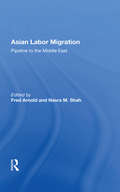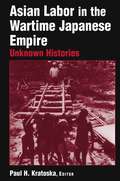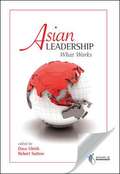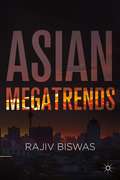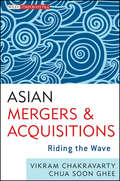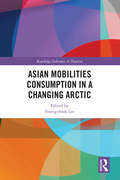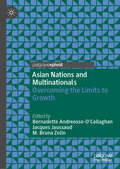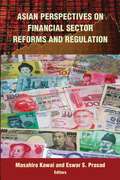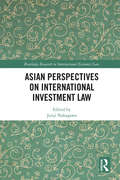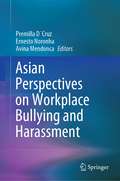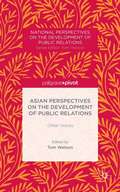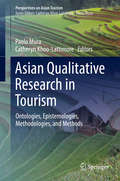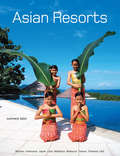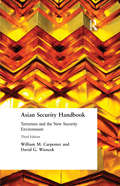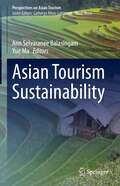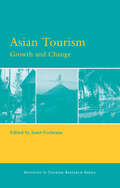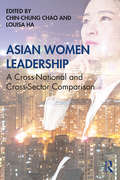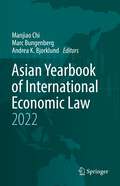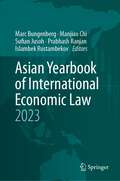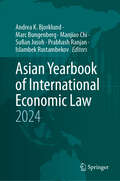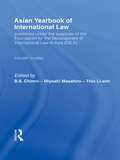- Table View
- List View
Asian Labor Migration: Pipeline To The Middle East
by Fred ArnoldLabor migration from Asia to the oil-exporting countries in the Middle East has burgeoned in the last decade to a current level of over two million workers. Because foreign labor contracts have become a potent source of foreign exchange to the sending countries in Asia as well as a safety valve for high unemployment, the export of labor has become
Asian Labor in the Wartime Japanese Empire: Unknown Histories
by Paul H. KratoskaDuring the Pacific War the Japanese government used a wide range of methods to recruit workers for construction projects throughout the occupied territories. Mistreatment of workers was a major grievance, both in widely publicized cases such as the use of prisoners of war and forced Asian labor to construct the Thailand-Burma "Death" Railway, and in a very large number of smaller projects. In this book an international group of specialists on the Occupation period examine the labor needs and the recruitment and use of workers (whether forced, military, or otherwise) throughout the Japanese empire. This is the first study to look at Japanese labor policies comparatively across all the occupied territories of Asia during the war years. It also provides a graphic context for examining Japanese colonialism and relations between the Japanese and the people living in the various occupied territories.
Asian Leadership: What Works
by Robert Sutton Dave UlrichThe Singapore Ministry of Manpower convened a Third Executive Roundtable in 2010 to examine the various challenges confronting leadership renewal in the Asian business context, especially in the aftermath of the global financial meltdown and economic downturn of 2009. The intensive session, spread threw up illuminating examples and astute observations on the subject, which were peppered with thoughtful anecdotes and penetrating truths that will titillate the reader.
Asian Megatrends
by Rajiv BiswasAsian Megatrends assesses the key drivers impacting Asia over the next two decades. The rise of China is transforming the Asia-Pacific, as China’s economic and military might increasingly reverberates throughout the region. India and Indonesia are also rising Asian powers that are changing the shape of the Asian economic landscape. The rapid growth of emerging Asian consumer markets is becoming an increasingly important growth engine for the world economy and for global multinationals. However, Asia faces tremendous economic and social challenges over the long-term, including the rapid growth of Asian megacities and severe environmental problems due to climate change, water crises and pollution. Geopolitical tensions have also been escalating in the Asia-Pacific due to territorial disputes in the South China Sea and the East China Sea, increasing the risk of a regional arms race and military confrontation.
Asian Mergers and Acquisitions
by Soon Ghee Chua Vikram ChakravartyA fascinating look at the unique nature of mergers and acquisitions in AsiaThe Asian market is heating up, and both local and international firms are looking to get in on the mergers and acquisitions (M&As) that are poised to play a pivotal role in the restructuring of all manner of industries. This restructuring will increase competitiveness, but to make the most of it you need to understand why M&As in Asia are unique. With Asian Mergers and Acquisitions: Riding the Wave in hand, you have everything you need to do just that.Packed with invaluable information on how Asian M&As work, the book points to the fragmented nature of Asian countries, markets, and customers, the rise of Asian economies and firms, and the growth of cross-border business driven by the need for companies to gain access to markets, technologies, and brands as key elements for understanding the market.Lays out guiding principles for Asian M&As, including identifying the drivers for creating value, mitigating cultural differences, getting the best expertise in pre- and post-merger efforts, and moreContains everything investors need to know to understand coming changes in the Asian marketDetails how Asian M&As differ from those in other countriesProviding clear insights into Asian mergers and acquisitions and their inner workings, including do's and don'ts for successful investment, this book is essential reading for anyone looking to cash in--or simply understand-- the rapid growth of Asian industry.
Asian Mobilities Consumption in a Changing Arctic (Routledge Advances in Tourism)
by Young-Sook LeeThis book provides an in-depth examination of the growing Asian tourism market and consumption in Arctic destinations. Through five parts, the book covers Asian mobilities consumption as an extension of Arctic international politics, the transportation sector and green cruise tourism, and ethnicity, culture, and history. It contributes to further understanding of the impacts of increased tourism in these polar regions by exploring climate change, debates around emerging economies and global power roles in the political, socio-economic, security and legal issues of the Arctic and Antarctic and associated polar strategies and policy. By drawing on a range of disciplines and with contributions from experts in Arctic destinations or who are associated with the Arctic, it further provides a holistic framing of emerging demand and mobility patterns of Asian tourists in a polar context. Asian Mobilities Consumption in a Changing Arctic will be valuable reading for students and academics across the fields of tourism, economics, sustainability, development studies as well as other social science disciplines.
Asian Nations and Multinationals: Overcoming the Limits to Growth
by Jacques Jaussaud Bernadette Andreosso-O’Callaghan M. Bruna ZolinAlthough Asia has been the world engine of economic growth since World War II, growth rates have differed sharply among the countries of the region. Still, all Asian countries have experienced some degree of growth limitation. Japan is facing the crucial issue of a quickly aging and shrinking population, a situation that South Korea is bound to face in the near future too. China, which still enjoys relatively high growth rates, is dealing with an exhaustion of its export-led growth model based on low wages, as well as huge and unprecedented environmental problems. In addition, food supply is still a concern for most Asian countries in spite of huge increases in productivity in the agricultural sector, the main reason being that global demand for food products has been increasing at an even higher speed. This edited collection focuses on the policies – at the macroeconomic level – and strategies – at the micro-meso economic levels – that need to be deployed in order to overcome the limits to growth in a post-global financial crisis and export-led growth context. It will be of interest to all scholars of economics, management and the political sciences who work on the economies of East Asia, and also to all those who work on the theme of 'transition economies'.
Asian Perspectives on Financial Sector Reforms and Regulation
by Eswar S. Prasad Masahiro KawaiAlthough emerging economies as a group performed well during the global recession, weathering the recession better than advanced economies, there were sharp differences among them and across regions. The emerging economies of Asia had the most favorable outcomes, surviving the ravages of the global financial crisis with relatively modest declines in growth rates in most cases. China and India maintained strong growth during the crisis and played an important role in facilitating global economic recovery.In this informative volume, the second in a series on emerging markets, editors Masahiro Kawai and Eswar Prasad and the contributors analyze the major domestic macroeconomic and financial policy issues that could limit the growth potential of Asian emerging markets, such as rising inflation and surging capital inflows, with the accompanying risks of asset and credit market bubbles and of rapid currency appreciation. The book examines strategies to promote financial stability, including reforms for financial market development and macroprudential supervision and regulation.
Asian Perspectives on Financial Sector Reforms and Regulation
by Eswar S. Prasad Masahiro KawaiAlthough emerging economies as a group performed well during the global recession, weathering the recession better than advanced economies, there were sharp differences among them and across regions. The emerging economies of Asia had the most favorable outcomes, surviving the ravages of the global financial crisis with relatively modest declines in growth rates in most cases. China and India maintained strong growth during the crisis and played an important role in facilitating global economic recovery.In this informative volume, the second in a series on emerging markets, editors Masahiro Kawai and Eswar Prasad and the contributors analyze the major domestic macroeconomic and financial policy issues that could limit the growth potential of Asian emerging markets, such as rising inflation and surging capital inflows, with the accompanying risks of asset and credit market bubbles and of rapid currency appreciation. The book examines strategies to promote financial stability, including reforms for financial market development and macroprudential supervision and regulation.
Asian Perspectives on International Investment Law (Routledge Research in International Economic Law)
by Junji NakagawaWith changes to the international investment law landscape and Asian countries now actively developing their network of bilateral investment treaties (BITs) and free trade agreements (FTAs), this volume studies issues relating to Asian perspectives on international investment law and forecasts the future of Asian contribution to its science and practice. The book discusses the major factors that have been driving Asian countries to new directions in international investment rule-making and dispute settlement. It also looks at whether Asian countries are crafting a new model of international investment law to reflect their specific socio-cultural values. Finally, the book examines whether there are any ‘Asian’ styles of international investment rule-making and dispute settlement, or if individual Asian countries are seeking specific national ‘models’ based on economic structure and geopolitical interests. This unique collection is exceptionally useful to students, scholars and practitioners of international investment law, international trade law and public international law.
Asian Perspectives on Workplace Bullying and Harassment
by Ernesto Noronha Avina Mendonca Premilla D’CruzThis book showcases empirical studies on workplace bullying from a range of Asian countries, including China, India, Indonesia, Israel, Japan, Jordan, Malaysia, Pakistan, Singapore, South Korea, Sri Lanka, Thailand, UAE and Vietnam, and is the first-of-its-kind single academic project documenting workplace emotional abuse in the world’s largest continent. It encompasses the ‘varieties of workplace bullying’ conceptualization in addition to category-based harassment and abusive supervision, and presents target, bystander and interventionist perspectives, along with contextualized insights into the phenomenon. The book speaks to the significance of sociocultural factors and draws on several theoretical and substantive bases including dignity, social cynicism, coping, gender, sexual orientation, job insecurity, turnover intention, affective events theory, attribution theory, regulation and policy initiatives. Covering all major regions in Asia where workplace bullying has been found to occur, namely West Asia, South Asia, Southeast Asia and East Asia, the book portrays studies which engage both positivist and postpositivist paradigms, utilize an array of methods and include a range of industrial sectors and employment contracts and all levels of the organization. While focused on Asia, the book’s insights have international relevance and are of interest to the worldwide community of researchers, practitioners and students of organizational studies, human resource management, industrial sociology, work psychology, industrial relations, labour law, corporate law, health sciences, social work and Asian studies.
Asian Perspectives on the Development of Public Relations: Other Voices
by Tom WatsonThe National Perspectives on the Development of Public Relations: Other Voices series is the first to offer an authentic world-wide view of the history of public relations. It will feature six books, five of which will cover continental and regional groups. This first book in the series focuses on Asia and Australasia.
Asian Qualitative Research in Tourism: Ontologies, Epistemologies, Methodologies, And Methods (Perspectives On Asian Tourism)
by Paolo Mura Catheryn Khoo-LattimoreAddresses the issues and opportunities faced by researchers conducting qualitative tourism research in Asia.<P> Provides reflexive accounts from Asian tourism scholars as well as non-Asian academics who focus on the region.<P> Pulls together the work of both authoritative figures in the field and emerging qualitative tourism researchers.<P>This book explores the ontologies, epistemologies, methodologies, and methods that inform tourism qualitative research conducted either by Asian scholars or non-Asian scholars focusing on Asia. In addition to providing a platform for researchers to publish their qualitative journeys, it aims to encourage further Asian qualitative tourism research production.<P> The book not only includes chapters from Asian scholars but also non-Asian tourism researchers with a focus on Asia, as their chapters are crucial to represent the multiplicity of realities constituting ‘Asia’. It is of interest to the whole tourism academic community as it provides novel methodological insights from a non-Western perspective, which at the moment are often silenced by dominant (Western) voices.
Asian Resorts
by Akihiko Seki Elizabeth Heilman BrookeBe it the mountain hot spring retreats of Japan or the crystal clear waters of the Pacific, this exploration takes you to the most exquisite resorts around Asia. Along with breathtaking photographs taken by the author, Asian Resorts includes exclusive stories based on firsthand interviews. This book drops you right into a dream world of the healing powers of a natural spa, the fresh air that comes with forest hikes, the amazing wonders of snorkeling amidst tropical coral reefs, and the simple joys of fishing, golfing, exotic cooking and more.
Asian Security Handbook: Terrorism and the New Security Environment
by William M. Carpenter David G. Wiencek James R. LilleyThis thoroughly revised and updated edition of Asian Security Handbook focuses on the new challenges to security in the Asia-Pacific region presented by international terrorism. It reviews old security realities covered in previous editions, and highlights more recent security issues in the region, including the North Korean threat, weapons of mass destruction proliferation, the South China Sea dispute, and the future U.S.-China rivalry. Featuring contributions by a distinguished group of international security and Asia experts, this new edition has been reformatted and restructured. A new introductory chapter on terrorism sets the stage for the country-by-country profiles and assessments of the political-security situations in twenty-three individual nations. A new appendix on foreign terrorist organizations is also included.
Asian Style Hotels
by Jacob Termansen Kim Inglis Pia Marie MolbechWith more than 500 ravishing full-color photographs, Asian Style Hotels brings you to the best hotels in Southeast Asia. The super-deluxe establishments included here are all at the cutting-edge of hotel design and management. Each property has been hand-picked according to a set of criteria that includes a strong design aesthetic, architectural integrity, and a sense of individuality a million miles away from the cookie-cutter approach of chain hotels. Asian Style Hotels is the definitive guide to Southeast Asia's finest places to stay.
Asian Tourism Sustainability (Perspectives on Asian Tourism)
by Yue Ma Ann Selvaranee BalasingamThis book brings together a collection of chapters that investigate sustainable tourism development in different Asian contexts; from stakeholders’ perspectives, existing issues in the market, as well as the impacts of COVID-19 on tourism. It highlights the importance of tourism sustainability in Asia. Specifically, this book examines these themes by examples related to Asian tourism such as; social-cultural impact of sustainable growth, environmental constraints and policies, community engagement, moral limits of the market, stakeholders’ participation in tourism development, the hindered interaction between foreign tourists and local community, impact of the pandemic and proposed ways forward. This edited volume substantiates this by using evidence of quantitative, qualitative and mixed methods approaches aligned with empirical data to show sustainable efforts and impacts. This book is of interest to researchers and practitioners as it offers timely understandings of sustainable tourism from multiple perspectives within the Asian context.
Asian Tourism: Growth And Change (Advances in Tourism Research)
by Janet CochraneTourism in Asia is growing faster than anywhere else in the world, driven by the increasing wealth of countries like Taiwan, South Korea and Malaysia, and by the huge populations of China, India and Indonesia -the first second and fourth biggest countries in the works. Despite the significance of the tourism industry in this area it is still under researched. Asian Tourism is a unique book and the first to addresses this imbalance by providing a high quality edited collection of chapters which explore the domestic and intraregional tourism in Asia. Divided into three sections it explores:* Policy aspects of tourism development and the role of the public sector exploring issues such as: Cross-national tourism collaboration in Asia, The growth of aviation in Asia and Economic Corridors and Ecotourism.* Changing markets exploring issues such as: The role of Japanese popular culture in Asian tourism, Management Challenges for Bali’s Tourism Industry and religious tourism in North India.* Destination and industry responses exploring issues such as: Tourism-Generated Employment in Cambodia, sex workers and tourism in India and responsible destination development in the Philippines.With contributions from well respected and eminent names in the field, Asian Tourism provides a ground breaking insight into topical, industry focused issues while benefiting from academic depth and rigour and an awareness of tourism history in this region.
Asian Trade and Investment in Europe (Routledge Studies in the Modern World Economy)
by Prana Krishna Biswas Robert DygasThis book provides deep insight into the flow of foreign direct investment from Asia to Europe. It assesses the topic of trade and investment from the reverse direction, considering Asian countries as the capital investors in the EU countries. Each chapter analyses either the international trade or investment of one or more Asian countries in correlation with one or more European states. The book analyses a significant number of countries, which are included in various economic associations, such as the Visegrad Group, the Three Seas Initiative, the European Free Trade Association, or are states from the same geopolitical region – for instance, the Iberian Peninsula, Baltic States, and Nordic countries. It examines Indian outward foreign direct investment trends in the UK before and after Brexit, based on select case studies, to emphasize the impact of Brexit, as well as to encourage trade and investment among Asian and European countries before and during COVID-19, to highlight the influence of the pandemic on the target country’s economy. The authors use a variety of analytical methods in the book, such as numerical presentations, econometric analysis, descriptive statistical analysis, an examination of time-series dynamics, the modelling of functions, and semi-structured interviews with company executives. The regional perspectives bring new and useful insights to the topic, and the case study approach allows for a wider exploration of the research questions as well as their theoretical evolution. The book provides a "big picture" for economists, researchers, business analysts, and PhD students of economics, international trade, and business.
Asian Women Leadership: A Cross-National and Cross-Sector Comparison
by Chin-Chung Chao Louisa HaThis book is an interdisciplinary anthology grounded in scholarly research that offers a concise but in-depth examination and exposition of leadership that helps readers better grasp the basics of the various aspects of Asian leadership and examines the practices of Asian women leadership across sectors in Asian and western countries. While many leadership books effectively describe leadership styles and/or outline various approaches to leadership, this book focuses on Asian women leadership and illustrates performed styles, experiences, opportunities, challenges and management strategies across sectors ranging from higher education, business, nonprofit organizations, the media industry, politics and social movement to immigration, using both quantitative and qualitative approaches. It can serve as a handy reference for aspiring women leaders, academic researchers, general readers and students who want to study Asian women leadership, work in Asian societies and/or work with Asians.
Asian Yearbook of International Economic Law 2022 (Asian Yearbook of International Economic Law #2022)
by Marc Bungenberg Manjiao Chi Andrea K. BjorklundThe Asian Yearbook of International Economic Law (AYIEL) 2022 addresses the rapidly evolving field of international economic law with a special focus on Asia and the Pacific. This region has long been and remains a major engine of the world economy; at the same time, it is characterized by a host of economies with varying developmental levels, economic policies and legal jurisdictions. The AYIEL 2022 especially focuses on trade law, investment law, competition law, dispute settlement, economic regulation and cooperation, and regional economic integration, as well as other legal developments in Asian countries.
Asian Yearbook of International Economic Law 2023 (Asian Yearbook of International Economic Law #2023)
by Marc Bungenberg Sufian Jusoh Manjiao Chi Prabhash Ranjan Islambek RustambekovThe Asian Yearbook of International Economic Law (AYIEL) 2023 addresses the rapidly evolving field of international economic law with a special focus on Asia and the Pacific. This region has long been and remains a major engine of the world economy; at the same time, it is characterized by a host of economies with varying developmental levels, economic policies and legal jurisdictions. The AYIEL 2023 therefore focuses on international economic law, especially on security and industrial policy.
Asian Yearbook of International Economic Law 2024 (Asian Yearbook of International Economic Law #2024)
by Marc Bungenberg Sufian Jusoh Manjiao Chi Andrea K. Bjorklund Prabhash Ranjan Islambek RustambekovThe Asian Yearbook of International Economic Law (AYIEL) 2024 addresses the rapidly evolving field of international economic law with a special focus on Asia and the Pacific. With the rapidly changing geopolitical situation, protectionist measures have been taken by many countries, which has caused significant impact on international economic governance. Given the importance of Asia and the Pacific, it is necessary to study on trade protectionism and its impacts especially from a regional perspective. The AYIEL 2024 therefore focuses on &“Protectionism and International Economic Law&”, exploring the recent trade measures taken by leading economies amid the changing geopolitical and geoeconomic situation, as well as the potential impacts of these changes on Asian countries and beyond.
Asian Yearbook of International Law: Volume 13 (2007) (Asian Yearbook of International Law)
by B.S. Chimni–Miyoshi Masahiro–Thio Li-annLaunched in 1991, the Asian Yearbook of International Law is a major refereed publication dedicated to international law issues as seen primarily from an Asian perspective, under the auspices of the Foundation for the Development of International Law in Asia (DILA). It is the first publication of its kind edited by a team of leading international law scholars from across Asia. The Yearbook provides a forum for the publication of articles in the field of international law, and other Asian international law topics, written by experts from the region and elsewhere. Its aim is twofold: to promote international law in Asia, and to provide an intellectual platform for the discussion and dissemination of Asian views and practices on contemporary international legal issues. Each volume of the Yearbook normally contains articles and shorter notes; a section on State practice; an overview of Asian states participation in multilateral treaties; succinct analysis of recent international legal developments in Asia; an agora section devoted to critical perspectives on international law issues; surveys of the activities of international organizations òf special relevance to Asia; and book review, bibliography and documents sections. It will be of interest to students and academics interested in international law and Asian studies.
Asian Yearbook of International Law: Volume 14 (2008) (Asian Yearbook of International Law)
by B. S. ChimniLaunched in 1991, the Asian Yearbook of International Law is a major refereed publication dedicated to international law issues as seen primarily from an Asian perspective, under the auspices of the Foundation for the Development of International Law in Asia (DILA). It is the first publication of its kind edited by a team of leading international law scholars from across Asia. The Yearbook provides a forum for the publication of articles in the field of international law, and other Asian international law topics, written by experts from the region and elsewhere. Its aim is twofold: to promote international law in Asia, and to provide an intellectual platform for the discussion and dissemination of Asian views and practices on contemporary international legal issues. Each volume of the Yearbook normally contains articles and shorter notes; a section on State practice; an overview of Asian states participation in multilateral treaties; succinct analysis of recent international legal developments in Asia; an agora section devoted to critical perspectives on international law issues; surveys of the activities of international organizations of special relevance to Asia; and book review, bibliography and documents sections. It will be of interest to students and academics interested in international law and Asian studies.
